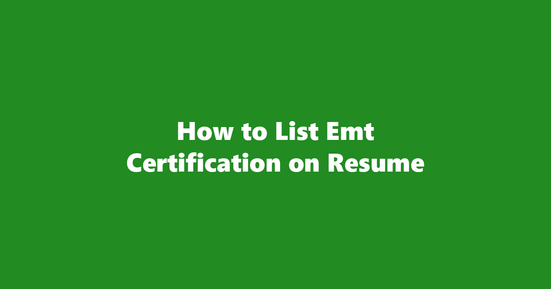Emt Certification on Resume
Complete guide on listing emt certification on your resume. Learn proper formatting, placement strategies, and see real examples that help you stand out to employers. Includes tips for highlighting your emt skills effectively.

What Is EMT Certification
The National Registry of Emergency Medical Technicians (NREMT) issues the Emergency Medical Technician (EMT) certification. This credential validates core skills and knowledge essential for providing basic emergency medical care, including patient assessment, CPR, trauma care, and handling medical emergencies. The EMT certification is highly significant in the healthcare industry, ensuring a minimum standard of competency for responders who provide critical care during emergencies.
To be eligible for EMT certification, candidates typically need to complete an approved educational program, pass the NREMT cognitive and psychomotor exams, and meet specific state requirements. The validity period for the EMT certification is two years, after which renewal is required through continued education and retesting. Preparing for the EMT certification can take several months, depending on the individual's prior knowledge and learning pace; IT is considered challenging due to its practical and theoretical components.
Should I Include EMT Certification on Resume?
Including an EMT certification on a resume depends on factors such as industry, career stage, geographical location, and the recency of obtaining the certification. For job seekers in healthcare or emergency services, the EMT certification can significantly increase their chances of being considered for relevant positions. If the certification has recently been obtained, IT is essential to include IT on the resume.
In some cases, such as a career change or applying for non-emergency roles, including the EMT certification might be less important but could still demonstrate transferable skills like teamwork, problem-solving, and adaptability. Job seekers should tailor their resumes to specific positions and industries, focusing on highlighting relevant certifications and experiences.
Hiring Managers And EMT Certification on Resume
Hiring managers view an EMT certification as a strong indication of a candidate's emergency medical knowledge, practical skills, and dedication to the field. Specific skills or qualities associated with this credential include:
- Patient assessment and care
- CPR and basic life support
- Trauma care and management
- Communication and teamwork in high-stress situations
In the healthcare industry, an EMT certification sets candidates apart from their competitors by showcasing their commitment to saving lives and emergency response. However, potential negative perceptions can arise if a candidate lacks additional qualifications or relevant experience in specific roles.
How to List EMT Certification on Resume
Properly list your EMT certification as follows:
Emergency Medical Technician (EMT) - Certified, National Registry of Emergency Medical Technicians (NREMT)
-
Valid through [Expiration Date]
-
Recertification in progress (if applicable)
Include the certification number/ID if IT is required for the job application. Note any expiration or renewal dates to demonstrate your commitment to maintaining current knowledge and skills. Mention the certifying organization, NREMT, for clarity. If you have an in-progress certification, list IT separately with a note that IT is pending completion.
Where to List EMT Certification on Resume
The optimal placement for the EMT certification on a resume depends on its relevance to the position:
- Include IT in a dedicated certifications section, making IT easily accessible for hiring managers.
- If the certification is closely related to the job, list IT under the relevant skills or experiences section.
- For candidates with limited work experience, consider including the EMT certification in the education section alongside degrees and other certifications.
- When listing multiple certifications, prioritize those most relevant to the position or industry.
- In a summary or professional profile, briefly mention your EMT certification if IT is highly relevant to the target role.
Examples of How to List EMT Certification on Resume
Example 1 - Technical Resume
Certifications EMT Certification, The American Heart Association (January 2020 – Present)
This format works well for a technical resume as IT keeps the focus on skills and certifications while maintaining a clean, easy-to-read structure. By listing all certifications in one section, the reader can quickly scan and identify relevant qualifications without having to search through the entire document.
Example 2 - Recent Graduate
Education & Certifications Bachelor of Science in Nursing, XYZ University (August 2019 – May 2023) EMT Certification, The American Heart Association (January 2020 – Present)
Including both education and certifications in one section is a practical choice for recent graduates. This allows employers to quickly grasp the educational background as well as any relevant professional qualifications. By listing the EMT certification under this section, IT reinforces the candidate's readiness and dedication to their chosen field.
Example 3 - Dedicated Certifications Section
Professional Development EMT Certification, The American Heart Association (January 2020 – Present) CPR Certification, The Red Cross (March 2018 – March 2022) Advanced Cardiac Life Support (ACLS), The American Academy of Pediatrics (April 2021 – April 2024)
When a candidate has multiple certifications in their field, IT can be beneficial to dedicate an entire section to showcasing these qualifications. This format helps emphasize the candidate's ongoing commitment to professional development and their expertise within the industry.
Example 4 - Skills-First Resume Format
Skills EMT Certification (The American Heart Association, January 2020 – Present) Basic Life Support (BLS), The Red Cross (March 2018 – March 2022) Advanced Cardiac Life Support (ACLS), The American Academy of Pediatrics (April 2021 – April 2024)
In a skills-first resume format, the emphasis is on showcasing relevant abilities and qualifications in an easily scannable list. By listing the EMT certification alongside other essential skills, the candidate demonstrates their readiness for immediate employment while providing employers with valuable insights into their expertise at a glance.
Copyright ©2025 Workstory Inc.